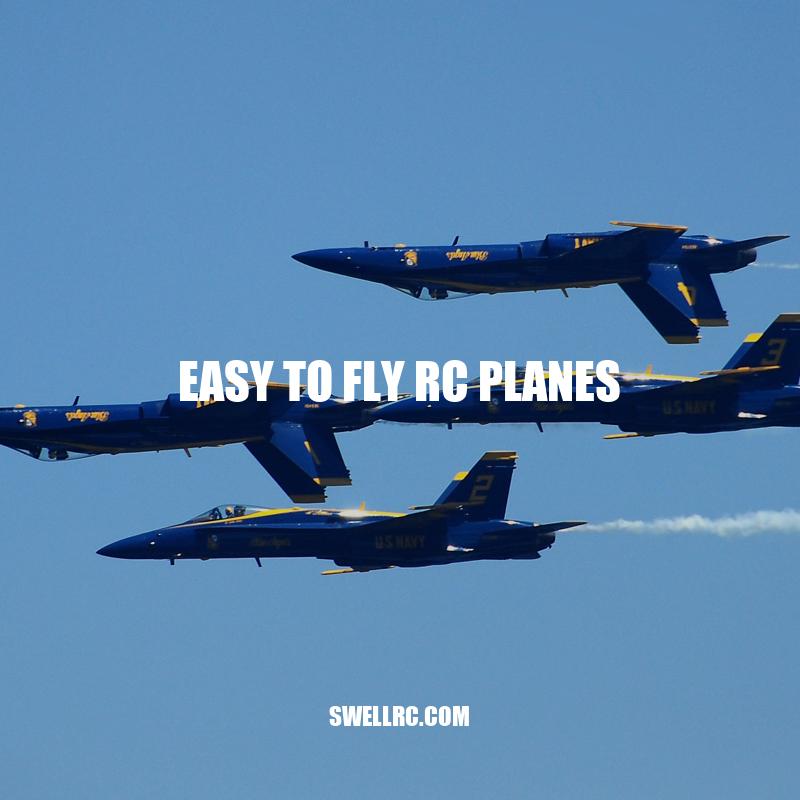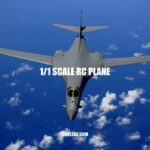Beginner’s Guide to Easy-to-Fly RC Planes
RC planes are an exciting and engaging hobby. They offer an experience unlike anything else as pilots control miniature aircraft soaring through the air. However, if you are new to the hobby, it can seem daunting to find a suitable RC plane to start with. Flying remote-controlled aircraft takes a specific level of skill, and beginner pilots need to start with easy-to-fly options. The good news is that many incredible and highly-rated RC planes are specifically designed for novice pilots. These planes offer stability and simplicity, so you can learn to fly efficiently and have fun doing it. In this article, we will explore what makes RC planes easy to fly and the best types for novice pilots. We will also provide tips on how to choose and fly a beginner-friendly RC plane to make your first flying experience successful and enjoyable.
Types of RC Planes
Before you start flying RC planes, it’s essential to know the different types available in the market. Here are some of the easiest RC plane categories to start with:
- Trainer Planes: These planes have high wings, stable designs, and larger configurations that offer smooth and easy flying experience for beginners. You can find various trainer planes like the HobbyZone Carbon Cub S2 and the E-Flite Apprentice STS.
- Glider Planes: They are motor-less planes and give you the chance to try flying with less motor interference. They are excellent for beginners as they are more stable with many features that make them easy to fly. The HobbyZone E-flite Night Radian FT is an excellent option for a beginner glider plane.
- Electric Planes: Electric RC planes are perfect for beginners as they are easier to fly compared to gasoline or nitro-powered planes. The E-flite UMX Turbo Timber BNF Basic and the Hyperion Super Chipmunk are some of the best options for easy-to-fly electric planes.
Knowing the different types of RC planes will help you choose the best plane that suits your skill level and preferences. However, it’s crucial to keep in mind that each type has its pros and cons, so do your research before making any purchases. Many websites such as Motion RC and Horizon Hobby offer a vast range of beginner-friendly RC planes that you can choose from. With proper research and guidance, you can find an easy-to-fly RC plane that will be just right for you.
What are the different types of RC planes?
There are different types of RC planes available in the market, some of them are:
- Trainer planes: These are designed for beginners, they have a high wing and slow flight speed, making it easier for beginners to learn to fly.
- Scale planes: These are replicas of real-world planes and have a realistic design and flight characteristics. They are perfect for experienced pilots who want to experience flying a specific plane.
- Sport planes: These are designed for aerobatics and stunts, they have a high speed and maneuverability, and can perform complex flight patterns and tricks.
- Gliders: These planes are launched via a tow line or hand launch and are designed to stay aloft on rising air currents. They don’t have a motor, making them silent and peaceful in the sky.
Some popular RC plane manufacturers are Horizon Hobby, HobbyZone, E-Flite, and Great Planes. These manufacturers offer a wide range of options for all types of RC plane enthusiasts. There are also many online RC plane stores such as RC Planet, Tower Hobbies, and Hobbytron that offer a variety of planes and accessories.
Features of Easy-to-Fly RC Planes
Easy-to-fly RC planes have unique features that make them beginner-friendly. Here are some essential features:
| Feature | Description |
|---|---|
| Stability | Easy-to-fly RC planes should be stable in the air, making it easier for beginners to control them. |
| Durability | Beginners tend to crash more, so easy-to-fly planes should have sturdy designs that can withstand minor crashes. |
| Lightweight | The lighter the plane, the easier it is to control and reduces the potential for damages in case of crashes. |
| Simple Controls | The controls should be user-friendly, making it easy for beginners to navigate the plane. |
| Flight Stabilization System | Some beginner planes come with flight stabilization technology that helps correct any imbalances in the air, making it more stable and easier to control. |
Easy-to-fly planes should also come with detailed instructions, illustrations, and support that will help you understand the operating process. For instance, the ParkZone, and E-flite. You can purchase them online on the company’s website or other reputable sites like Amazon and eBay.
Finally, know that flying RC planes is a fantastic hobby and an excellent way to meet new people with the same interest. As you improve your flying skills, you will enjoy trying new tricks and planes, making the experience more exciting and fun.
What makes a plane easier to fly?
A plane can be easier to fly depending on its design and features. Some factors that make a plane easier to fly are:
- Simple cockpit controls
- Good visibility for the pilot
- Stable flight characteristics
- Effective landing gear and brakes
- Modern avionics and navigation systems
Website(s) or product(s) that may provide additional information on this topic include aviation forums, pilot training courses, and aircraft manufacturers’ websites such as Boeing and Airbus.
Tips for Choosing Easy-to-Fly RC Planes
Choosing the right easy-to-fly RC plane for you as a beginner can seem overwhelming. Here are some tips to help you narrow down your options:
- Start with a trainer plane: Trainer planes are specifically designed for beginners. They are stable, easy to handle, and can withstand minor crashes. They also come with extra features like flight stabilization systems and can be flown in smaller areas
- Consider the Size: Smaller planes are less expensive, easier to store, and can be flown in smaller areas, making them perfect for beginners.
- Price: As a beginner, do not break the bank by investing in high-end planes until you have enough skills to handle them effectively.
- Brand Reputation: Buy from reputable brands that are known to produce high-quality and beginner-friendly planes. Some recommended brands include HobbyZone, ParkZone, and E-flite.
- Customer Reviews: Check product reviews online to see what experiences other customers have had with the planes you are interested in purchasing.
When shopping for easy-to-fly planes, there are numerous websites where you can find these types of planes. In addition to manufacturer sites, you can also buy from popular online retail stores such as Amazon, eBay, and Banggood.
It is also important to note that while easy-to-fly planes are aimed at beginners, they still require some level of skill and practice. If you are new to RC planes, it is recommended that you seek the assistance of an experienced pilot who can help you learn and become more comfortable flying. RC clubs offer beginners mentorship and a community to help you improve your skills.
What is the best RC plane for a beginner?
For beginners, the best RC planes are usually those that are easy to fly and durable. Some of the best RC planes for beginners include:
- HobbyZone Sport Cub S
- E-Flite Apprentice S 15e
- Dynam Hawk Sky V2
- Volantex Trainstar
These planes have different features that make them excellent choices for novices. For example, the HobbyZone Sport Cub S has a Panic Recovery mode that helps beginners regain control of the plane with ease. The Dynam Hawk Sky V2 is known for its durable foam construction and is resistant to damage caused by crashes.
If you’re looking for recommendations on the specific RC planes available for purchase, you can check out websites like Horizon Hobby or Amazon for more information; they have a wide variety of options available.
Flying Tips for Beginners
Flying an RC plane can be both exciting and challenging. It requires a combination of skill, patience, and practice. If you are a beginner, here are some tips to help you make your first experience as smooth as possible.
First and foremost, take your time and avoid rushing into complex maneuvers. Start with small and simple movements such as going up and down. As you become more comfortable, you can progress to more complex maneuvers. Additionally, you might want to;
– Launch: When launching your plane, be careful not to throw it too hard, a gentle slide is the best way to go.
– Landing: Make sure to land from the same direction as much as possible to prevent disturbances and air currents. Trigger an approach early and keep a steady angle to make your landing smooth.
– Avoid Crowded Places: Flying in public spaces is not only dangerous but could also result in legal repercussions.
– Be Mindful of Weather: Strong winds and rain can make it tough to fly, always check the weather before going out.
– Don’t fly alone: Flying with a friend or at an RC club where more experienced pilots can watch and advise you helps you improve your skills safely.
In conclusion, flying an easy-to-fly RC plane as a beginner can be a fun and rewarding experience. Choosing the right plane, practicing in a safe place, and learning the basics of flying can help you become a successful RC pilot. Remember to always follow safety rules, respect other pilots, and have fun!



